“Hello Al,
As I mentioned in my last posting, I have been killing time waiting for my locomotives to be modified to run on battery.
They finally arrived and I have been having a great time running them around my layout.
For those of you who have not built your layouts yet, I recommend that you look into this method of running.
There is no wiring to be done, you never have to clean your tracks and you can ignore all polarity problems with reverse loops and turntables and such since the track is not powered.
I run On30 with DCC and sound and have an NCE system installed.
The installation involved isolating the motor from the wheels, adding a Radio Control Receiver and battery control circuit into each locomotive and supplying a battery pack.
The system has a transmitter that I plugged into my NCE track output connectors so that I can use my existing system to run my trains.
The system will function just fine with or without DCC.
If you want to go the DCC route, all you really need is the decoders installed into your locomotives and a Radio Controlled hand set to complement the battery controlled system.
For DC the same applies except you don’t need the decoders obviously.
I installed the the transmitter inside the roof of my depot and have included pictures of the components to give you an idea of what they look like.
The yellow looking thing is the battery pack. It’s about 1/2 the size of my thumb and powers my locomotives without any problems.
I have run with the bell and whistle on and found no hesitation in operation with these little battery packs.
I don’t know how long they will run without requiring a charge as they are still going strong.
The system runs on OO/HO and up but maybe could go down to N scale as well.
I elected to have one system placed into a separate car so that I could attach it to other locomotives without major modifications. All I would need to do is add a plug from the tender into the trailing car.
I forgot to mention that the system comes with an Off/On switch as well. I hope this gives some of the more adventurous of you some ideas for the future.
Bob”
A big thanks to Bob, his post really reminded me of Richard’s:
That’s all for today folks.
Please do keep ’em coming.
And maybe, just maybe, today is the day where you recapture the fun of your last layout: the Beginner’s Guide is here.
Best
Al
PS Latest ebay cheat sheet is here.

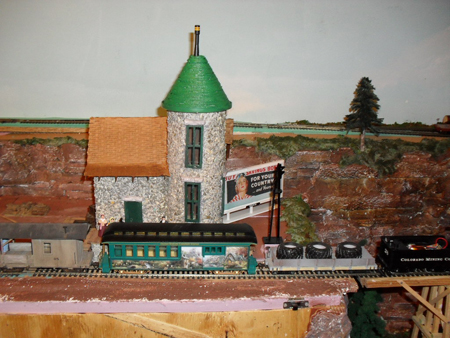
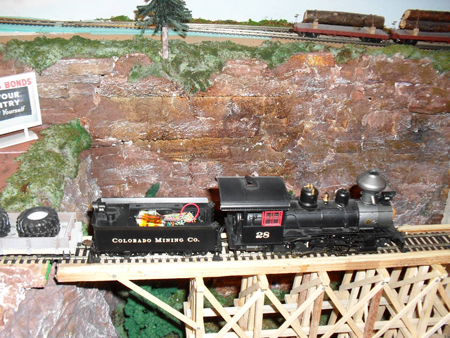
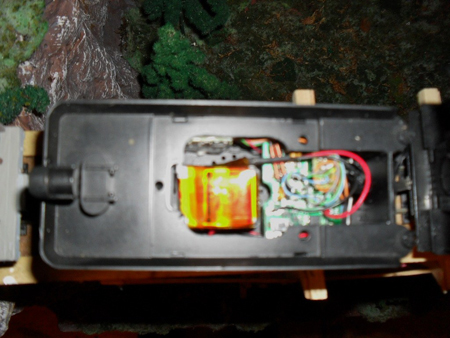
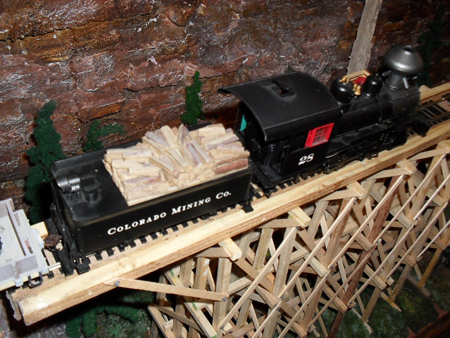

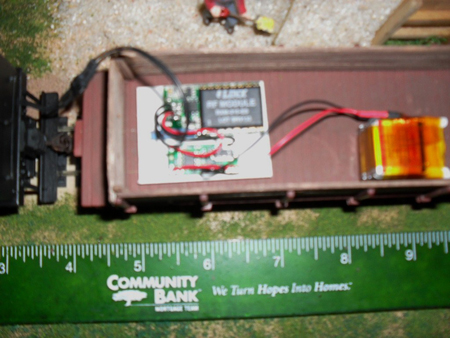

No why did n’t I think of that? Brilliant. If anyone can find a way to get this working with old N gge I’d love to know. I have used an old 12v battery to power a circuit outside and I’ve also used one of those 9v & 12v plug-in battery chargers/power units instead of a transformer & controller for a small exhibition
layout that just round at one speed. Thanks for this int. D/
wow amazing layout and amazing idea, best wishes on your upcoming layouts. if you could send me some emails for lans of layouts and anything to do with 00 gauge that would be FANTASTIC!!!
best regards Jacob
Good idea
thank you. New adventure in deed! Can you saw more about the conversion routs?
Del
Very cool.
For those of Us with various amounts of electrical,
and electronic experience.
Where can We order, and approximate cost of parts?
Thanks !!! Duwayne
Nice layout. Doing N scale would probably have to use a unit of rolling stock to have a place to put the batteries. To bad that we don’t live in an age where nano technology an it is just a trip to the local Radio Shack to get the materials to build a hybrid engine that keeps the batteries charged when it is running around the layout. Oh well what a nice daydream to have….
Sounds like the ideal format for a garden railway especially in the UK.
Okay, for your ‘N’ scale idea, here is an answer:
The simplest way would be to take a boxcar or passanger car and wire up a set of rechargeable ‘AAA’ power cells in series, (equal to the required volatge of your engine), with a micro S.P.D.T. slide switch and secure the power pack to the inside bottom of the car. Then wire that up to a set of polarized micro sized plug and socket set that is connected to your engine by running thin stranded wires along the bottom edge of the cars. Of course, the power car would need to be nearest to the engine in the train consist. The power car then can be recharged using the same connector and matching socket mated to a proper power charger. If you create two cars the same way and connect them in parallel, When one is discharged, throw the switch ‘off’ on that car and throw the switch ‘on’ of the other car, and away you go.
What is the cost involved to fix locos and other items?
Great idea. It is an energy saving idea as well. Too many power packs run up the old electric bill pretty fast. I’d like to have a better idea of how long the batteries last.
Bob, you did a great job. I would not have thought of battery power.
Great new idea. If the system could be adapted to N and the cost was reasonable it would certainly put it to the DCC producers who are presently gouging for decoders and electronics. The idea of control without wiring is even closer to the real thing. Good show. Keep the information coming.
Brilliant. That would have saved me a ton of frustration a time or two.
Are you using a rechargeble battery?
Can I use a similar system on my new Garden railroad? Can I use the same DC motor in my current engine and just add a controller?
Check out the RC car hobby. There are lots of ideas to be gleaned from this quarter. That’s how I got started with my G scale stuff. I also have On3 trains running on batteries on a shunting puzzle layout I built for my grand kids. Coupling/uncoupling and switching is all done manually.
RC gear for N gage is readily available, but it can get costly due to the miniaturization, but I predict it will soon be the norm for all scales.
batteries WOW!
A great invovation …
More on this would be great. Same questions as all the others battery life and cost.
Still I like it.
Thanks Bob and Al
regards,
Tom
Dirty track is dirty track and wheels will slip and stick and run poorly on it even if they’re not drawing power from it. Also this system could get expensive if the batteries do not last long, and will electric bills go down if they need to be frequently recharged?
I dunno, it seems to me as if one might just give up the fuss of wiring (usually only once?) and track cleaning for the fuss of always changing and replacing and charging batteries?
Time will tell I guess, but I’m in no hurry to give up the reliability of always available clean electrical power, and tracks will always have to be cleaned somewhat anyway…
To all who asked;
I researched this on the internet and found a great deal of information about radio control w/battery operation. Also, there are many groups that provide advise and help with this part of the hobby. You can also check out hobby shops and groups that work with radio controlled model cars, boats and planes. I picked the DRS1 system because I already had a DCC layout and wanted to use everything I already had installed. I elected to have my locomotive motors isolated from the wheels but this is not necessary especially if you want to run on battery or with track voltage as well. Although this may not be the solution for most, I am sorry I didn’t know about this technology a few years ago …. I could have saved a bundle and a whole lot of time wiring my layout.
I HAVE A BATTERY TRAIN BY BACHMANN. IT IS 49MH BUT I NEED A TRANSMITER FOR IT. DO YOU KNOW WHERE I CAN FINE ONE. THANK YOU.
one guy asked if it would cut your elec bill down if you where charging the battery. Duh , if that is a problem then put a small solar panel out to recharge them. Other thing that you can add on is a side rail for charging and put a fullwave bridge recatifer in the system and power up a side rail just for charging AC/DC IT WOULD NOT MATTER if it was AC or DC with a fullwave rec. and they are very small
if wired right you won’t need to worry if the rail polarity was right or not , cause the rec. works it out on its own. I had one on my CB radio cause the trucks I drove , I never knew the truck was – or + ground so the full wave rec took care of that problem for me.
Hi Bob, I saw an HO train at one of the shows. I inquire about. The owner did it himself and suggest I do the same, because it takes some work and knolage, therefore will be expensive to have it made.
I just have not the knwolage but with instructions I could do it.
Find a busines in St. Petersburg, Florida: Archies at 4200 62nd Ave. N. Phone 727-526-0394
Am planing on going that rout in my back yard. Good size and not the best for gardening.
Will apreciate you advise. Paco gayon 20500 Cot Rd. Unit 320, Lutz. Fl. 33558
Some thoughts on the battery powered layout…
1st… GREAT JOB!!!!!!!!!!
2nd… For those that are interested, check out Dead Rail… on the web and on Facebook
3rd…The first I experienced this was by observing an Athearn F7 A-B set with Hobbytown Drive… Don Feihman had brought the locomotive to an NMRA meet in Sacramento (About 1970) He also wrote an article on the locomotive that was published in Railroad Model Craftsman (about the same year). The radio equipment and controller were built by Mr. Feihman (An amateur radio enthusiast (Ham) and an electrical engineer. The most amusing thing about the locomotive was that it was built in the pre-digital age and used tonal controls. — For those who knew the tones and had a walkee-talkee set to the correct frequency, the locomotive could be controlled by whistling the correct pitch into the radio transmitter.
All the best,
John Reynolds
I am not sure about larger scales but, n nscale you still need to clean the track. The dirt on the track builds up on the wheels of the rolling stock until it will no longer stay on the track. It is great for operation because dirty track does not cause poor or rough performance. I prefer my standard dcc because of weight. The radio control system requires the instalation of batteries in rolling stock and I have a mainline that has a maximium two percent grade. I like to pull one hundred plus cars on my trains and the batteries are just to much weight. I do keep an eye on the technology and as battries get smaller and lighter I may try it again in the future.
The system — you mentioned that the “system plugs into your NCE DCC controller.” By “system” do you mean somehting off the shelf or did you ahve to jerry rig a connection to your dcc controller?
Very interesting tell us more. Who sells the battery operated units
can i convert my g scale trains there all outdoors and i can never get them to run good electricity thru track and i have to clean tracks everyday…help me please
Good idea how much does it cost. John from MILWAUKEE WISCONSIN
I had my G guage trains 3 of them on Battery with the batteries in a box car.Lithum batteries could run about 5 hours with out charging. Here in Fla with salt air and corrosion the batt were great. A very good experience.
Hello there, You’ve done a fantastic job. I will certainly digg
it and personally suggest to my friends. I’m sure they’ll be
benefited from this website.
Very interesting, can someone please explain what a full bridge rec is? Hopefully with a wiring diagram. Thanks so much Tom in AZ
Battery powered trains sounds like an interesting idea. By adding a bridge rectifier and a voltage regulator (cheap, small, light weight, and readily available parts) between your battery and your pick-up wheels, you could use smaller (lighter weight) batteries, and the engine would recharge itself while running on DC or DCC track voltage. A recharging track would not be required. Reversing loops would not need to be powered. Sounds like a win-win situation to me.
Keep on training,
Carl in Kansas
There was a guy in our club who had battier powered engines and converted to DCC. He said the battier powered units were all different. We model is S gauge.
One plus is that you NEVER have to trace an intermittent track wiring lead! I HATE having to do this … the circuit ALWAYS works when I’m testing, yet screws up when running! If the loco isn’t running, I’ll check the LOCO! The only thing is now blocks aren’t isolated, preventing collisions!
Bluerail trains now offer a Dead Rail system which includes the power board, a magnetic on/off switch & a battery pack all wired & ready to go. You download the app to operate it to your mobile phone or tablet for free. Nothing else required. Its available for both apple & android devises.. The app has many features including sound for diesel & steam locos. Their is also a video on the web page to explain how it works. Google bluerail & their web page will come up. Hope this helps.
Great – just what i needed. I am starting again at 82 and radio/battery would be just right, Can i go straight in or must i have DCC first?.
Ian
The battery solution to running is the way to go. Lego trains changed from track power to battery power. This would be particularly useful for a garden layout, where track conductivity becomes poor. You can run three different engines, if I remember correctly, with one radio controller in Lego. I believe there is a super business opportunity for someone who can come up with a system that is easily fitted to existing OO scale trains. With minitrurisation I am sure “N” scale would also benefit.
A detailed explanation of how it can be fitted and how it works would be very welcome for non-electrical buffs like me. I really think this could make running more reliable. I watch with interest! Thanks!
Where can I find equipment to convert my electric to battery power?
Think batteries would be the way to go on nighttime/lighted billboard scenery.Remote control and LED’s.Another idea I had was to utilize an old watch face and make a town tower with a WORKING clock.We already know watch batteries can last years and are not that expensive.Same with electronic car key fobs.If you know the frequency(used to unlock your car from a distance) this could be your “remote”.Have not started my layout until after I move.If someone else tries this let me know how it worked and what was used
OH BTW,with my clock idea,if you are an “era” builder/modeler simply remove that sweep second hand and it will look like an old “ticker. A scratch built model of Big Ben on a layout using this would look AWESOME
If you would use the rails to keep the batteries charged a pickup on the inside of the rails might be something to think about for dirt and oil. Also if you kept the batteries charging while running you might not need as many to save weight.
Please help me restore my fathers home made suitcase set…it was 9v and then 12v and then i blew it up soo…battery pack for the AAA might be the way to go…the only problem is I have no idea how to do it though have been using a soldering iron since I could walk…please please please refer me to any videos that you may know of that may assist even just a little bit…many thanks inadvance…kat
Great idea. The traditional electrical wiring is imbedded in my head and at my age, whoops, I’ve said to much, it’s not easy changing old thinking. Then again, mom and dad grew up without TV and now we’re mobile@#$&*:)
I hope that you will excuse my commercial plug and delete if not appropriate but we’ve designed and been selling an out-of-the-box system for battery power, wireless control since 2015 and we have several hundred users, scales include O, OO/HO and we have demonstrated our next products in larger N gauge locos. Please visit protocab.com for more details.
Thanks for this info. Might be interested in doing this since,i only have my mainline wired
About 2 yrs. ago I checked on Li-ion cells. Since then I have a collection of about
20. The size is 18650, a big fat AA cell, rated from 3Ah to 5.8Ah. Cell holders are available from single to multiple an many shapes. Some suppliers include charger.
Fully charged they measure abt. 4.2 volts each. They don’t seem to suffer from the ill’s of nicads and don’t loose the charge while sitting. For model RR use, a diode bridge can be installed and A.C. placed on the tracks to charge while sitting or running on dirty tracks. Always be sure to limit the current with a resistor or automotive stop or turn signal lamp. Good Luck, have fun.
I have been waiting for that one unique person who explains what DCC is. I am familiar with isolated block wiring and the “Command control systems” such as the one that was written about in Model Railroader Magazine with a full tutorial.
I also recall one company that did offer a radio controlled system, but like all radio controlled devices you must operate on different frequencies lest one controller takes control of another car or plane, etc. That system was setup for two locomotives out of the box.
My one concern or focus is that I have an old Troller control which provides either pulse or direct power and it provides that super slow, realistic start and slow gradual stops. I’d still want to have that feature or capability.
Frank in Orlando
For me, I don’t think that batteries are there yet, as far as making them feasible for long-term use with trains. Especially if you are like me and let things sit for weeks before deciding on a whim to run the trains. I would be always concerned about charging and/or changing batteries, and whether they are about to die because they have been sitting for too long. One we get train batteries that will last a bit longer, and be able to be charged while in the train, on the track in a designated wireless charging zone, then I will consider using batteries.
nice work